![]()
![]()
![]()
![]()
![]()
![]()
![]()
![]()
![]()
![]()
![]()
![]()
![]()
Archives & Museum Informatics
158 Lee Avenue
Toronto, Ontario
M4E 2P3 Canada
info @ archimuse.com
www.archimuse.com
| |
Search A&MI |
Join
our
Mailing List.
Privacy.
published: April, 2002
Learning by Design: Teachers / Museums / Technology
Lisa Korteweg, University of British Columbia, Canada and Brenda Trofanenko University of Illinois Urbana-Champaign
Abstract
Information technologies in museums are being touted as the means to create a dynamic interface and intersection between a museum’s resources and teacher engagement. An emerging concern in educational research is how the introduction of information technologies into museums – digitalized artifacts, Web-based resources, on-line professional development for teachers – has spurred both an influx of undocumented learning with museum collections and a wave of pedagogical activities created in isolation to increase ‘museum’ learning by users. We argue the need to rethink the relationship of teachers, museums, and museum education, to acknowledge the on-going and significant role museums can hold in teachers’ professional development. The museum's educational imperative, whether or not aimed specifically at teachers' professional development, continues to advance the museum’s power to educate through its exhibits and programs. A new design of collaboration is necessary for the museum Web site to reach a successful operational status within the teachers' and museum's expectations. We draw on comparisons between three museum Web sites to examine how each site seeks to better engage and influence teacher learning.
Keywords: collaboration; museum education; professional development; interactivity
Introduction
The crucial link between successful pedagogical purpose and effective technological tool and resource utilization in classrooms is the teachers. Their pivotal role informs the significance of teacher professional development in technology learning, as is well recognized in educational research (Pea, 1998; Cuban, 2001). As museums move into the realm of professional development, primarily through the development and implementation of museum Web sites, the crucial link for these museums is continued Web site use by teachers. It is not surprising that teachers utilize museum Web sites as sites for curriculum development. Yet teachers face various obstacles in integrating technologies into their curriculum (Kravchyna and Hastings, 2002). Teachers are often expected to achieve this pedagogical integration in their spare time, at their own expense, and often in isolation, without consistent support or 'training' (de Castell, Bryson & Jensen, 2002; Lotherington, Moreby, Granger & Doan, 2001). A frequent result is a fumbled approach positioned as professional development, where teachers are attempting to engage in their own learning and to transfer the technical knowledge and skills into pedagogically valuable classroom experiences. Others refuse to engage in a systemically unstructured, financially unsupported arena of non-existent professional development altogether (de Castell & Bryson, 1998).
As educators committed to educational theorizing about technology, we recognize the ‘promising’ frustrations and discomfort that technology can usher into education and to educators. The access to and view beyond the classroom world has been narrow, myopic and comfortable in scope and message, limited specifically to classroom textbooks and school library reference books. Available knowledge has grown to incalculable multiple perspectives, sometimes conflicting and critical, delivered through broadband connection to school computers. The educational promise for teachers who wish to utilize museum-based education Web sites, however, has yet to be fulfilled by this merging of school computers and Internet access. Problems persist, not the least of which is the design and support of professional learning for teachers and for all professionals involved in the implementation of technologies in education, including software designers, technical support, and museum educators and curators.
Technological advances are becoming mainstream in museums – specifically in Web site development and exhibition design. In addition to growing financial commitments to educating the public, museums are making available extraordinary electronic resources for students and teachers. The world presented through digitized museum collections is often richer and more heterogeneous than what has typically been found inside the classroom. Electronic museum resources not only offer digital access to museum collections, but also allow teachers to view artifacts with curatorial interpretations and museum-educator-generated lesson plans. As museums disseminate electronic representations of artifacts into the public realm (including schools), epistemological problems arise for the museum and the teacher. What knowledge about the artifact is transmitted between the museum and the teacher (and, subsequently, the students), and how each recipient will gain that knowledge, challenge the learning intent of the individuals involved. A response by some in the museum community to maintain their educational purpose is to post a cache of lesson plans on the Web site, providing step-by-step guides on how the museum's expertise can by transmitted or transferred to the student through the teacher's instruction.
While the listing of lesson plans in the museum’s education Web pages may be a first step in the promising role museum Web sites occupy, we suggest that it is not enough. It cannot begin to match the promise of digitized artifacts: the promise to increase student (and teacher) curiosity, challenge preconceptions, make connections between unrelated subjects, pursue inquiries, explore complex relationships with diverse communities, and a multitude of other types of intellectual endeavors (see Clifford and Friesen, 2001). We are advocating increased involvement of teachers in the design of museum Web-based learning activities and, similarly, a design of learning for teachers themselves on how the museum may play a role in their curriculum construction and delivery. The museum needs to reconsider how the learning theories inherent in their on-line lesson plans and education Web pages limit the degree to which teachers can effectively play a role in student learning. Such a change in the roles of both the museum and the teacher will require re-designing the existing institutional arrangements between museums and educators. Museum professionals will have to recognize and grapple with the particular pedagogical contexts in which teachers work; and, teachers will need to consider the types of learning possible through the museum's domain (through representations, pedagogical approaches, access to experts/researchers) that can be now extended beyond the museum's walls.
In this paper, we explore how museums are poised to engage in a new design of professional collaboration with teachers directly through electronic means. This is not to suggest that museums will move beyond exhibiting artifacts and artworks. Rather, we consider how artifacts are translated via technology for specific pedagogical purposes, and how the pedagogical intents and benefits that brought teachers initially to museum Web sites need to be explored and further expanded. We frame our examination of two different types of museums – fine arts and science – as a means of acknowledging the various educational approaches museum educators and curators are developing. In the Seattle Art Museum Web site, we examine the Teacher Resource Pages, specifically the teacher units or packages intended to augment the understanding of certain exhibits of now mostly un-digitized items. In the Exploratorium Web site, we focus on the Institute for Inquiry, where we examine how the institution created a sub-institution of academic researchers, museum educators and teacher-educators to engage with the notion of inquiry science; and how its sustained and ongoing association with teachers provides the pedagogical innovations and resources for on-line teachers. Finally, we consider the CyberMuse project at the National Art Gallery of Canada, that combines promising multimedia techniques to communicate curatorial texts associated with eight profiled works of art.
We frame our critique primarily from an educator’s perspective, in order to understand those instances where museum Web resources could aid in a collaboration between museums and schools generally, and between museum educators and teachers specifically. The idea is to acknowledge those promising Web environments where teachers and museums could develop sustained interaction with each other.
Sustained Interactivity: Deriving Benefits for Teachers and Teaching
In writing about the benefits for academics of studying teaching, educational theorist Michael Huberman (1999, p. 289) asserts sustained interaction patterns between teachers and academics, two distinct micro (social) worlds, “determine[s] the flow of knowledge.” He offers four premises about the flow of or points of contact in knowledge during educational research, suggesting that the knowledge resulting from the interactions is influenced by how “practitioners” and “researchers” in “research” sites consider their corresponding knowledge and perceptions. Although Huberman speaks specifically about educational research, his framework is applicable to ways teachers can work with curators and museum educators. As such, we have placed Huberman’s framework within the language of teachers, museums, and museum educators.
The first premise we explore is the way museums handle and characterize ‘the teacher’ in its Web site. This characterization stems from the museum's pedagogical approach; i.e., how it directs teachers to best utilize its resources. If teachers are considered a dynamic source of knowledge that can contribute to the advancement of an analysis of digitized collections and 'users' (and museum education), then the museum will approach the teacher in a different manner. Secondly, how the “micro-worlds” of museum education, on the one hand, and teacher practice in the classroom, on the other hand, interact determines what knowledge flows from the classroom to the museum, and vice versa. Third, the interaction between museums and schools, rather than solely between museum educators and classroom teachers, is crucial in order to understand how the museum as a whole benefits from a focus on education.
Sustained interactivity reframes the goal of (museum)
research from one of primarily informing the practitioner (teacher-user)
to one of jointly constructing knowledge through shared activity.
(Huberman 1999, p.291)
Finally, sustained interactivity between teachers and museum professionals may allow museums to refine, and eventually recast, their conceptual frameworks, methodologies, teaching, and modes of exchange with various audiences through electronic means.
Huberman’s theory suggests that the interactivity between schools and museums is based on the mutual understanding that each institution and its personnel have pedagogical worth that can contribute to the development of knowledge – knowledge important and valid for both micro worlds. A museum has to demonstrate its pedagogical worth to gain the allegiance of teachers and, consequently, their sustained use of the electronic museum. It has to prove itself effective for augmenting, enhancing or extending teachers’ practices. If not, the Web site remains unused by teachers in the classroom or it becomes a simple add-on in the manner that, perhaps, a museum field trip becomes an add-on experience to a classroom event. We question whether establishing this worth can be accomplished solely with the posting of templated lesson plans or uni-directional learning on museum Web sites.
We argue for increased interactivity or collaboration between teachers and museums to acknowledge teachers' pedagogical experience and knowledge, and teachers' abilities to utilize Web sites in ways not considered or yet perceived by museums. If teachers are to be included at all in such education, then museums need to account critically for the ways in which they seek to educate. Teachers significantly influence the likelihood of students returning to a museum Web site, both inside and outside of the classroom context. Teachers who reject the traditional lesson plan may be perceived by the museum as resisting the educational innovations currently occurring on museum Web sites. If we consider the teacher as holding great influence over the means and conditions through which students learn within classrooms, then sustained interactivity with teachers will assist the museum in achieving its educational outcomes: increased thoughtful usage by students and educational value for the public.
Of critical importance here in thinking about the relationship of teachers, museums, and museum educators is realizing the on-going and significant role museums can hold in teachers' professional development. The museum's educational imperative, whether or not aimed specifically at teachers' professional development, continues to advance the museum’s power to educate through its exhibits and programs. We argue it is in the best interest of teachers, museums, and museum educators to build a closer alliance and a shared agenda of sustained interactivity. Through a new design of collaboration, each micro world works to develop and implement digitized collections and on-line professional development, and extend museum activities, in order that the museum Web site reach a successful operational status within the teachers' and museum's expectations.
How, through professional development, teachers and museum professionals come to understand each other’s role in learning is by bringing ideas together to focus on how learning may be enriched through Web sites. To speak of sustained interactivity, as we are using the term here, is to look at how each social world is making sense of the educational mission of the museum through working together and sharing an always tentative theory of learning. As museums are concerned with the educational as well as the economic, we offer the following rationale for a more collective form of education.
The educational goals and activities that museums present on their Web sites need to be negotiated by the teacher, the museum personnel, and the Web designer. With constant negotiation there is greater involvement, commitment and investment in education in museums, in museums in education, and in the technology necessary to respond to the various social needs of each group. Through a reiterative, collaborative process, teachers may engage in developing and contributing to the museum’s Web site, to hook specific curriculum to the museum resources, and to make operational such resources for specific classroom contexts. In this way, teachers become brokers between the intended student audience and the museum’s educational intent. As teachers are best able to judge how their students are responding to museums' Web activities and technical designs, there is a wealth of data and information that museum professionals may gain from closer interactivity with their teacher-collaborators.
At a time when museums are experiencing the highest degree of attendance and an increased number of new institutions are opening (Harris, 1999; Pitman, 1999), the economic success of museums is always in flux. We realize that our call for increased collaboration is not without economic impact. To maintain both an institutional sustainability and Web site sustainability will cost money. We are otherwise missing the opportunity to learn about how to advance the educational mission of the museum and make classrooms more vibrant in the community. We suggest a more explicit collaboration in order to ensure the educational role is considered and evaluated in terms of its economic benefits to the museum and teachers.
To illustrate the interactivity that we advocate, we begin with instances where museum Web sites are attempting to reconsider and re-tool the relationship between the museum and the teacher. In each example, we focus on sites that show promise of greater interactivity with teachers (and students), but with a pedagogical design that still needs to promote “a community of exchange from which each party (museum professional and teacher) could profit in different spheres of activity” (Huberman, p. 299).
1. Seattle Art Museum
http://www.seattleartmuseum.org
Common to museum home pages is a separate education section, to be differentiated from general museum information, exhibition listings, volunteer activities, etc. As with the Seattle Art Museum, the education section is separate, listed under the general “Just for Fun” title (see Figure 1).
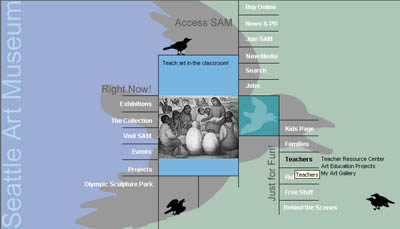
Fig 1. Seattle Art Museum homepage
http://www.seattleartmuseum.org
Within the Teacher section is an on-line database which provides access to information about teacher programs, school tours, online lesson plans and activities. In the unit Teach about Photography, a teacher guide is available with lesson plans created to accompany the exhibition An American Century of Photography: From Dry-Plate to Digital: The Hallmark Photographic Collection. The guide is comprehensive and thoughtful, focusing on artistic and subject matter choices made by photographers, providing the history of photography, asking questions and ideas incorporating the Washington State Essential Academic Learning Requirements, and including a glossary of terms. The accompanying pin-hole activity, photographs, and Youth in Focus create a pedagogically useful document for teachers.
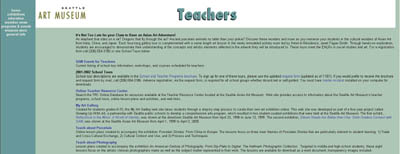
Fig. 2. Seattle Art Museum Teachers page: http://www.seattleartmuseum.org/teachers/default.htm
Absent from the generous and resourceful site is collaborative dialogue between the museum and educators themselves. The absent exchange denies possible problem-solving over pedagogical issues in the electronic delivery of museum resources. The site presents teachers as designated recipients rather than collaborators in this on-line venture. The electronic medium allows an asynchronous, open exchange of feedback and comments on documents that are intended for use and implementation by teachers. Yet the archived, static nature of the photography unit limits feedback between teachers and the museum concerning the educational successes of a comprehensive unit.
This Web site is a generous first step by a museum offering to engage with teachers in classroom practice and student activities and learning. Our question of this Web site is not only about museums realizing the success (or not) of their teacher education programs through collaboration and open communication and on-going additions to the unit, but also their placing units on-line that remain separate and distinct from the institutions’ current exhibits.
2. The Exploratorium’s Institute for Inquiry
http://www.exploratorium/edu/IFI/index.htm
While housed inside the Exploratorium’s Web site, the Institute for Inquiry remains invisible from the larger museum organization, with the resources and texts separate from the Exploratorium’s digitized exhibits and information resources (see Figure 3). With the current concern within the State Department of Education about mathematics education, the current Mathematica display provides a starting point for investigating not only the history of math (which it does), but also how math can be framed within an inquiry process (which it does not). As a part of Exploratorium’s programs, the Institute for Inquiry is separated from the Teachers Institute. (see Figure 3)
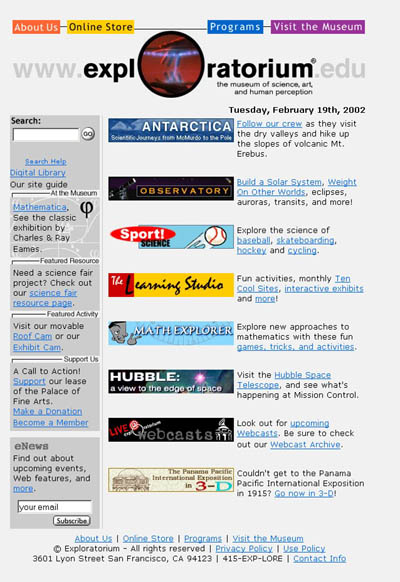
Fig. 3. Exploratorium homepage: http://www.exploratorium.edu/
As a part of Exploratorium’s Programs, the Institute for Inquiry is separated from the Teachers Institute (see Figure 4). The Institute for Inquiry concerns itself with means and methods for encouraging elementary teachers to attempt ‘inquiry science’ in their classrooms. The Institute pages have photographs of teachers during summer institutes, which seem to be a part of the Teachers Institute, grappling with the challenges and hands-on materials that the Institute facilitators have provided. Absent from the Web pages are references to Exploratorium resources and exhibits by faculty-authors. Although much information is presented about pedagogy vis-à-vis inquiry method, the teacher is situated in a site disconnected from the host museum’s resources. A possible perception gained is that the museum is indirectly associated with some valuable professional development materials.
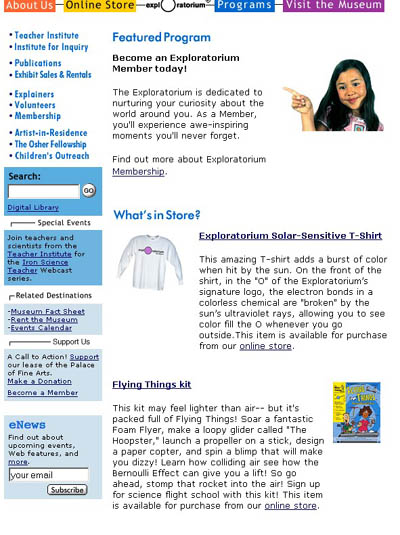
Fig. 4. Exploratorium Program page: http://www.exploratorium.edu/programs/index.html
Once the teacher has exhausted those pages, there is no connection for further development with the host museum of the Exploratorium. There is no direct lure or enticement to bring the teacher-user back into the Exploratorium pages. This suggests that the professional development is limited to the Institute for Inquiry pages (see Figure 5).
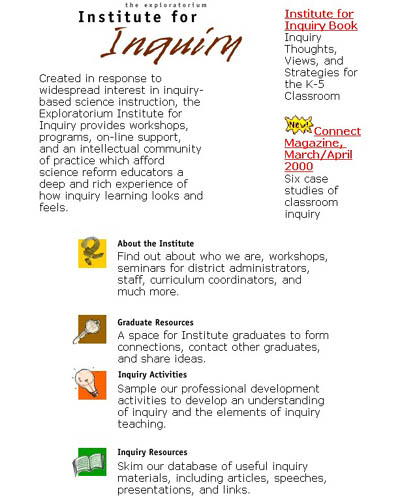
Fig. 5 Institute for Inquiry page: http://www.exploratorium.edu/IFI/resources/ifibook.html
3. National Gallery of Canada
http://national.gallery.ca/index_e.html
The National Gallery Web site offers a virtual space – CyberMuse – that holds the Gallery’s images, information, and ideas about art. This space holds over 5,000 images of works in the Gallery’s collections, with opportunity to provide a closer look at particular artists, artworks, and art styles (see Figure 6).

Fig. 6. CyberMuse page: http://CyberMuse.gallery.ca/ng/
The general public’s art education is extended by CyberMuse’s Favourites, a showcase featuring a selection of works accompanied by audiofile and videoclips of curatorial interpretation of the works and the artists. While this multimedia presentation is ready for classroom use, a lack of teacher guides or supports subverts pedagogical issues or concerns. The extent of teacher education is limited to education and public programs which provide directions for teachers to attend the physical space of the Gallery (see Figure 7). The curators direct the didactic learning in this site, and although claiming to offer a “complementary experience, a new level of interpretation” with the public, where “dialogue is important,” the educational orientation to teaching is to ignore teacher knowledge. This site teaches art, rather than showing a regard or interest in teaching about art. As such, it has excluded concerns educators may have with the site.

Fig. 7. Education and Public Programs page: http://national.gallery.ca/education/school/index_e.html
The Promise and Challenge of Museum Education Web Sites
In realizing how museums continue to work the tension of providing quality exhibits as well as fulfilling the larger public educational mission and expectations through Web sites, the examples we provide above initiate discussions about how museums interact with the teaching public. We realize a museum’s educational commitment reflects as well as legitimizes that museum’s collective and individual missions. Yet we also realize that in achieving these missions, a disconnect is occurring between what is offered in the physical spaces of the institution and what is presented on the Web sites to teachers.
Museums will remain powerful institutions for educating both teachers and students. Each example we have shown illustrates a different interpretation of the relationship between teachers and the museum community. The delivery system constructs teachers as specialized sub-groups that can assist museums in the ways in which Web-based knowledge is presented. Both the museums and the teaching profession need to reconsider their roles in education and draw from the collective ways in which knowledge may be transferred and learning may occur.
Further work is needed in both the educational and curatorial realms of museum education, broadly speaking. We argue the call for further engagement by teachers in questioning how museums include and exclude their presence on museum Web sites. Having seen the possibilities, we have become more convinced that teachers need to raise some of the unasked questions about what constitutes understanding, about authority of knowledge, and about education. An emerging sensibility among educational theorists who seek to understand museum education would argue the distinctive features of collaboration between teachers and museum professionals. The museum becomes a crucial ground for struggle over educational distinctions. Education, as publicly defined and delineated by museums, is presented as public objects to which all teachers have claim. In fact, a good deal of the museums’ educational credibility rests on clarifying the essence of the relationship with teachers.
There is nothing simple about the relationship between a museum and its teaching public. Calls from museum professionals and educators have made the relationship complex and contested. What once stood by museum tradition and understanding as an educational institution remains. The conceptualization of education hinges on how museums advance the ideas of education and collaboration during times when the concepts themselves are being questioned by various parties and by changes within the larger social and political arenas.
References
Bryson, M & de Castell, S. (1998). New technologies and the cultural ecology of public schooling: Imagining teachers as Luddites in/deed. Educational Policy, 12 (5), 542-567. Available: http://www.educ.ubc.ca/faculty/bryson/gentech/Luddites.html
Bryson, M., de Castell,, S., & Jensen, J. (2002). Object Lessons: Towards an Educational Theory of Technology. First Monday, 7 (1). Available: http://firstmonday.org/issues/issue7_1/castell/index.html
Clifford, P. & Friesen, S. (2001). The Stewardship of the Intellect: Classroom Life, Innovation and Technology, in B. Barrell (ed.), Technology, Teaching and Learning: Issues in the Integration of Technology. (pp.29-42) Calgary, AB: Detselig Enterprises Ltd.
Cuban, L (2001). Oversold and Underused: Computers in the Classroom. Cambridge, MA: Harvard University Press.
Harris, V. (1999). The divided house of the American art museum. (3), 33-56.
Huberman, M. (1999). The Mind is Its Own Place: The Influence of Sustained Interactivity with Practitioners on Educational Researchers. Harvard Educational Review, 69 (3), 289-319.
Kravchyna, V & Hastings, S.K. (2002). The Informational Value of Museum Web Sites, First Monday, 7 (2). Available: http://www.firstmonday.org/issues/issue7_2/kravchyna/index.html
Lotherington, M., Moreby, L., Granger, C. & Doan, L.( 2001). Tearing Down the Walls: New literacies and new horizons in the elementary school, in B. Barrell (ed.), Technology, Teaching and Learning: Issues in the Integration of Technology. (pp.129-161) Calgary, AB: Detselig Enterprises Ltd.
Pea, R. (1998). The Pros and Cons of Technology in the Classroom. Bay Area Reform Collaborative Funders’ Learning Community Meeting. Palo Alto, CA. Available: http://www.tappedin.org/info/teachers/debate.html
Pitman, B. (1999). Muses, museums, and memories. Daedulas Volume 128 (3) pp. 1-31.

